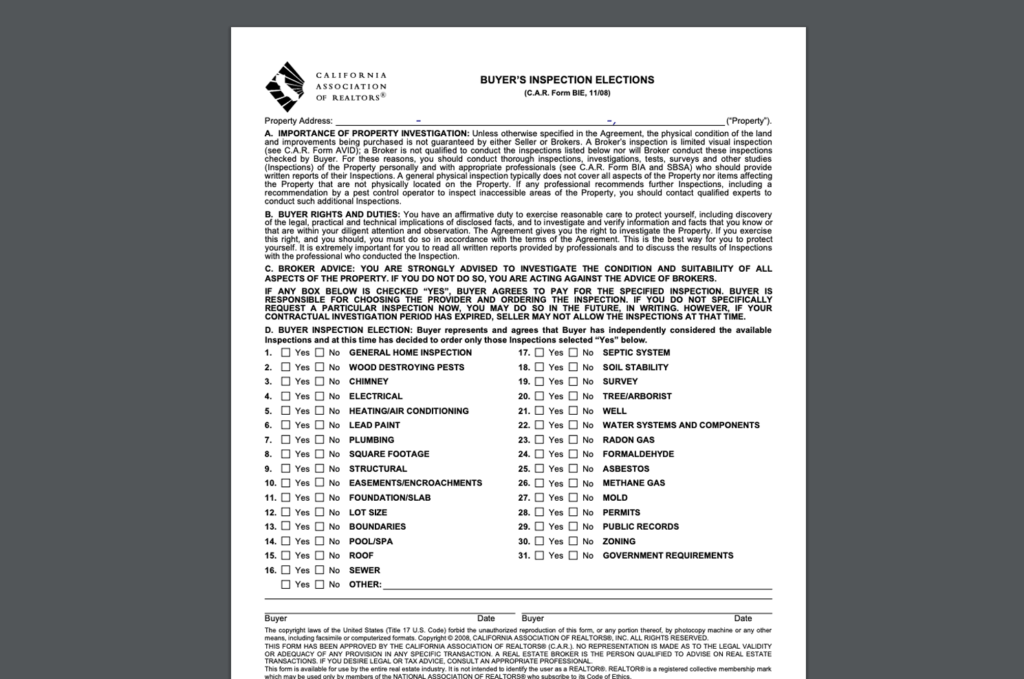Title: Understanding the BIE Buyer Inspection Election C.A.R. Form
When buying a property in California, it’s essential to conduct thorough inspections to ensure you’re making an informed decision. The California Association of Realtors (C.A.R.) has developed various forms to streamline real estate transactions, one of which is the Buyer Inspection Election (BIE) form. In this blog, we’ll delve into what the BIE form is and how to use it effectively.
What is the BIE Buyer Inspection Election C.A.R. Form?
The BIE form, officially known as the “Buyer Inspection Election” form, is a standardized document created by C.A.R. This form is designed to help buyers specify which inspections they want to conduct on a property before completing the purchase. It outlines the types of inspections available and allows buyers to select which ones they wish to perform.
How to Use the BIE Buyer Inspection Election C.A.R. Form:
- Obtain the Form: The BIE form can be provided by your real estate agent or downloaded from the C.A.R. website (or CLICK HERE). Make sure you use the most up-to-date version to ensure compliance with current regulations.
- Review the Types of Inspections: The form typically lists common types of inspections, such as general home inspections, termite inspections, roof inspections, and more. Carefully read through the options to understand what each inspection entails.
- Select the Desired Inspections: As a buyer, you’ll need to indicate which inspections you want to conduct by checking the corresponding boxes on the form. Be sure to discuss your choices with your real estate agent, as they can provide valuable insights based on the property’s condition and your specific needs.
- Specify Timeframes: The form will also include spaces for you to specify the timeframes within which you plan to complete the selected inspections. This is an important aspect of the form because it sets expectations for both parties involved in the transaction.
- Negotiate with the Seller: Once you’ve completed the form and submitted it to the seller or their agent, it becomes a negotiation point. The seller may agree to the inspections as proposed, counteroffer with different terms, or reject certain inspections altogether. Negotiating this aspect is crucial to reaching a mutually acceptable agreement.
- Perform the Inspections: After both parties agree on the inspection terms, it’s time to schedule and complete the inspections. It’s advisable to hire licensed and reputable professionals to conduct these assessments to ensure a comprehensive and accurate evaluation of the property’s condition.
- Evaluate the Inspection Reports: Once the inspections are completed, you’ll receive detailed reports outlining the findings. Review these reports carefully and consult with your real estate agent to determine how they impact your decision to move forward with the purchase.
- Proceed with the Transaction: Based on the inspection reports, you can decide whether to proceed with the purchase as initially agreed, negotiate repairs or credits with the seller, or, in extreme cases, withdraw your offer if major issues are uncovered that you’re unwilling to accept.
In summary, the BIE Buyer Inspection Election C.A.R. form is a valuable tool for California homebuyers to specify their inspection preferences and set expectations during the real estate transaction. It ensures transparency and helps buyers make informed decisions about their potential property purchase. Always consult with your real estate agent and consider seeking legal advice when using this form to protect your interests effectively.
If you have questions regarding this form, or who you might use to obtain these inspections, we are here to help. Depending on the home, we may have some insight as to suggested inspections as well as inspectors. Contact us anytime!





